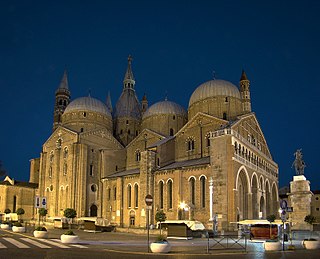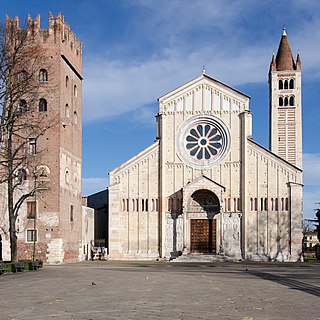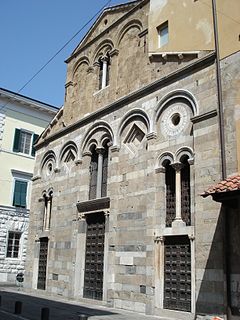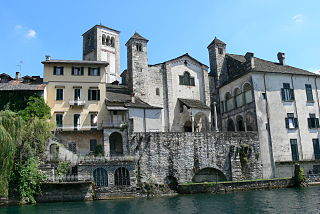

San Liberatore a Maiella is an abbey and church in the territory of Serramonacesca, in the province of Pescara, region of Abruzzo, Italy.


San Liberatore a Maiella is an abbey and church in the territory of Serramonacesca, in the province of Pescara, region of Abruzzo, Italy.
The origin of the abbey is traditionally linked to Charlemagne, who is portrayed in a fresco fragment within the church. The 9th century edifice was rebuilt a first time from 1007 by the Benedictine monk St. Theobald. It is dedicated to St. Liberator. [1]
The current edifice, however, is that rebuilt starting from 1080 by Desiderius, abbot of Montecassino.
The church remained in a decaying state until it was restored in 1967-1971.

The abbey has a white façade with balanced volumes, flanked by a square-plan bell tower with three floors, having (starting from the lowest) single, double and triple mullioned windows. The façade has vertical relief in Lombard-Romanesque styles.
The interior is on the basilica plan with a nave and two aisles, divided by seven round arcades with triangular piers.
The triumphal arches (the central one is now missing) led to the presbytery. The arches are supported by cruciform pilasters which end with notable decorations, in a style similar to that of the nave's walls. The ceiling has wooden trusses. In the left aisles are the former accesses to the cloister and the monastery residential quarters, represented by two decorated doors. One has in its tympanum the typical flower motif of the Abruzzese Romanesque style.
The nave's pavement has a rare pavement geometrical decoration which dates from c. 1200.
The apse has frescoes from various ages, once united but now, after their restoration, separated: the one portraying Theobald in from the 16th century, while the second, with traces of saints' figures, is from the 12th century.
The ambo has a square shape, and is similar to those in the San Clemente Abbey of Casauria and in that of San Pelino at Corfinio.
| Wikimedia Commons has media related to San Liberatore a Majella . |

Romanesque architecture is an architectural style of medieval Europe characterized by semi-circular arches. There is no consensus for the beginning date of the Romanesque style, with proposals ranging from the 6th to the 11th century, this later date being the most commonly held. In the 12th century it developed into the Gothic style, marked by pointed arches. Examples of Romanesque architecture can be found across the continent, making it the first pan-European architectural style since Imperial Roman architecture. The Romanesque style in England is traditionally referred to as Norman architecture.

Arezzo is a city and comune in Italy and the capital of the province of the same name located in Tuscany. Arezzo is about 80 kilometres southeast of Florence at an elevation of 296 metres (971 ft) above sea level. In 2013 the population was about 99,000.

Sestino is a comune (municipality) in the province of Arezzo in the Italian region Tuscany, located about 110 kilometres east of Florence and about 75 km (47 mi) northeast of Arezzo.

The Pontifical Basilica of Saint Anthony of Padua is a Roman Catholic church and minor basilica in Padua, Veneto, Northern Italy, dedicated to St. Anthony. Although the Basilica is visited as a place of pilgrimage by people from all over the world, it is not the titular cathedral of the city, a title belonging to the Cathedral-Basilica of St. Mary of Padua. The basilica is known locally as "il Santo". It is one of the international shrines recognized by the Holy See.

Prato Cathedral, or Cathedral of Saint Stephen, is a Roman Catholic cathedral in Prato, Tuscany, Central Italy, from 1954 the seat of the Bishop of Prato, having been previously, from 1653, a cathedral in the Diocese of Pistoia and Prato. It is dedicated to Saint Stephen, the first Christian martyr.

The Basilica di San Zeno is a minor basilica of Verona, Northern Italy constructed between 967 and 1398 AD. Its fame rests partly on its Romanesque architecture and partly upon the tradition that its crypt was the place of the marriage of Shakespeare's Romeo and Juliet. It stands adjacent to a Benedictine abbey, both dedicated to St Zeno of Verona.

Gothic architecture appeared in the prosperous independent city-states of Italy in the 12th century, at the same time as it appeared in Northern Europe. In fact, unlike in other regions of Europe, it didn’t replace Romanesque architecture, and Italian architects weren’t very influenced by it. However, each city developed its own particular variations of the style. Italian architects preferred to keep the traditional construction methods established in the previous centuries; architectural solutions and technical innovations of French Gothic were seldom used. Soaring height was less important than in Northern Europe. Brick rather than stone was the most common building material, and marble was widely used for decoration. In the 15th century, when the Gothic style dominated northern Europe and Italy, the north of the Italian Peninsula became the birthplace of Renaissance architecture.

San Cristoforo sul Naviglio is a church in Milan, northern Italy.

The Basilica of San Michele Maggiore is a church of Pavia, one of the most striking example of Lombard-Romanesque style. It dates from the 11th and 12th centuries.

San Pietro in Vinculis is a Romanesque-style, Roman Catholic church in Pisa, region of Tuscany, Italy.

The Basilica of Sant'Abbondio is a Romanesque-style 11th-century Catholic basilica church located in Como, region of Lombardy, Italy.

The Abbey of Vezzolano is an abbey in the territory of Albugnano, Piedmont, northern Italy, in Gothic–Romanesque style.

The Abbey of Santa Lucia is a medieval abbey in the comune of Rocca di Cambio, Abruzzo, central Italy, built in Gothic-Romanesque style and dating to the 11th-12th centuries.

Innichen Abbey is a former Benedictine monastery in Innichen, South Tyrol in northern Italy. Founded in the 8th century, its collegiate church dedicated to Saint Candidus, rebuilt in the 12th–13th centuries, is considered the most important Romanesque building in Tyrol and the Eastern Alps. It is home to a 13th-century sculpture and a fresco cycle from the same age in the dome.

Basilica di Santa Maria Assunta (Italian: Basilica Patriarcale di Santa Maria Assunta is the principal church in the town of Aquileia, in the Province of Udine and the region of Friuli-Venezia Giulia, Italy.

Ancona Cathedral is a Roman Catholic cathedral in Ancona, central Italy, dedicated to Saint Cyriacus. It is the seat of the Archbishop of Ancona. The building is an example of mixed Romanesque-Byzantine and Gothic elements, and stands on the site of the former acropolis of the Greek city, the Guasco hill which overlooks Ancona and its gulf.

Otranto Cathedral is a Roman Catholic cathedral in the Italian city of Otranto, dedicated to the Annunciation of the Virgin Mary. It is the archiepiscopal seat of the Archdiocese of Otranto. The cathedral was consecrated in 1088. It is 54 metres long by 25 metres wide and is built on 42 monolithic granite and marble columns from unknown quarries. Its plan is a three-aisled nave with an apsidal east end. On either side of the west façade are two lancet windows.

Trani Cathedral is a Roman Catholic cathedral dedicated to Saint Nicholas the Pilgrim in Trani, Apulia, south-eastern Italy. Formerly the seat of the archbishop of Trani, it is now that of the archbishop of Trani-Barletta-Bisceglie. Consecrated in 1143, is one of the main examples of Apulian Romanesque architecture.

The Basilica di San Giulio is a Roman Catholic church on the small Isola San Giulio in the center of Lake Orta, province of Novara, north-western Italy. It has the status of a minor basilica. Although the island is part of the Orta San Giulio municipality, the basilica belongs to the San Giacomo parish, including the island and a portion of the west coast of the lake in San Maurizio d'Opaglio municipality.